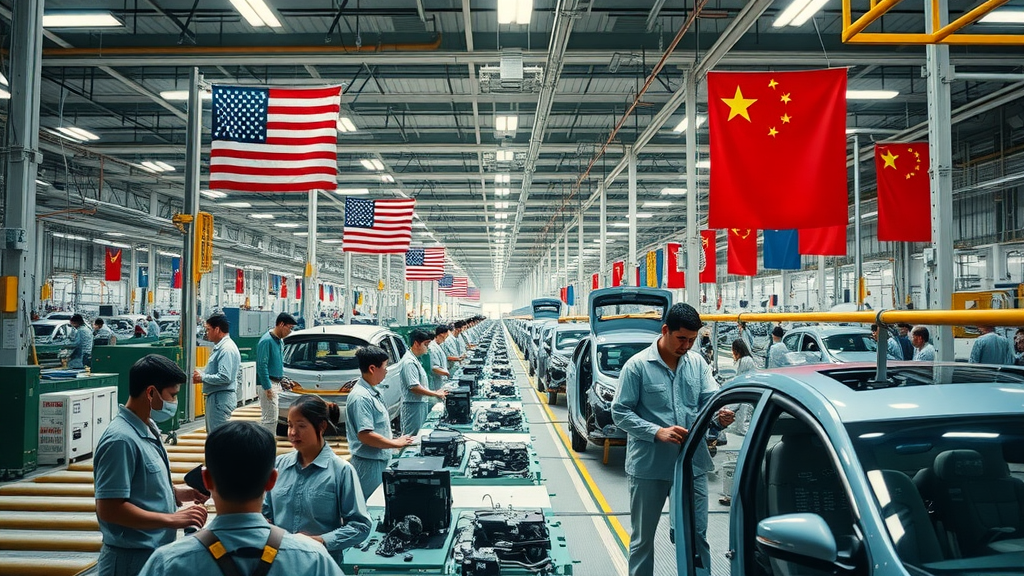Did you know that US tariffs have led to billions of dollars in additional costs for American consumers and businesses since 2018? These tariffs—applied to products from smartphones to soybeans—don’t just impact foreign manufacturers, they affect every trip to the store, every click online, and every budget-conscious family across the nation. The question of what products are affected by US tariffs goes far beyond statistics—it’s a daily reality shaping wallets, supply chains, and even diplomatic relations. Let’s dive deep into the products at the heart of global trade debates and see how the shifting policies hit both businesses and your bottom line.
Why Understanding What Products Are Affected by US Tariffs Matters Now
The landscape of global trade is changing rapidly, and at the core of this transformation is the sweeping implementation of tariffs by the United States on a vast array of imported goods. Knowing what products are affected by US tariffs is critically important not only for large multinational corporations but also for local businesses, family-run stores, and everyday consumers. Tariff rates can raise prices, shift supply chains, and create widespread uncertainty in the market, as companies scramble to adjust their sourcing and pricing strategies. If you’ve ever wondered why your favorite electronics cost more or why the price of steel for home renovations has gone up, tariffs are likely at the root.
Practical examples are everywhere—from American automakers grappling with higher steel and aluminum costs to the agriculture sector battling to find new markets for exports like soybeans. These disruptions come on the heels of trade deals being renegotiated and new tariffs emerging overnight. In today's fiercely interconnected world, being aware of which products face rising costs, delayed shipments, or shifting origins can help businesses maintain profitability and empower consumers to make smarter decisions when shopping for everything from cars to clothing to kitchen appliances.

How to Identify What Products Are Affected by US Tariffs
Navigating which items are subject to US tariffs can seem overwhelming due to the frequent policy changes and complex product lists. The government categorizes imports using the Harmonized Tariff Schedule, assigning specific tariff rates to each product code. By tracking updates from the US Department of Commerce and consulting the International Trade Commission’s public databases, businesses and consumers alike can quickly learn which goods bear higher duties and what their country of origin must be. Regular news updates and trade reports make it easier than ever to stay alert to changes that might affect supply chains or personal buying choices.
For businesses, understanding these lists helps determine whether to absorb costs, raise prices, or seek alternative suppliers. For consumers, awareness can prompt shifts in buying behavior—such as opting for local alternatives or postponing major purchases during periods of added tariff costs. Some products, like auto parts and electronics, may have a higher tariff rate depending on evolving diplomatic efforts and retaliatory measures. Keeping up with real-time updates is crucial to avoid unexpected surprises at the checkout counter or the warehouse dock.
“Tariffs have become a daily headline, but behind every number is a family-owned business, a local manufacturer, or an everyday shopper feeling the impact.”
The Scope: What Products Are Affected by US Tariffs in 2024
By 2024, the list of what products are affected by US tariffs has expanded and shifted dramatically. Tariff policies introduced by President Donald Trump and continued by successive administrations have covered hundreds of categories, reflecting changing priorities and ongoing global tensions. The focus has increasingly been on sectors vital to American competitiveness and national security, leading to widespread consequences for manufacturers, exporters, and ordinary consumers.
As America adjusts its stance in international trade—particularly in negotiations with the European Union , China, and India—the spectrum of goods affected has become broader and sometimes unpredictable. Companies large and small must now consider not only the base cost of goods but also the risk of future tariff rate hikes with every new trade deal or diplomatic dispute. This urgency for awareness drives businesses and shoppers to seek up-to-the-minute data before buying or stocking essential items.
Major Industries Most Affected by US Tariffs
- Electronics
- Steel & aluminum
- Automobiles
- Apparel and footwear
- Agriculture
Each major sector above has faced unique challenges due to higher tariffs . Electronics makers, often reliant on complex global supply chains, have adopted new strategies or sought exemptions. The steel and aluminum industries, long viewed as critical to national infrastructure, have benefited from government support even as automakers and construction firms pass along elevated costs. Apparel companies face shifting patterns in global sourcing, while agricultural businesses deal with both lost markets and newfound allies as traditional trade partners erect reciprocal tariffs of their own.
Because these sectors span the economy from raw materials to finished products, the ripple effects are vast: think about how a tariff on imported steel increases the price of home appliances, or why an extra duty on soybeans might make your next burger pricier. Uncertainty has also spurred some innovation, as businesses adopt new technologies or reroute manufacturing in efforts to minimize tariff exposure.

How President Trump and Successive Policies Redefined US Tariffs
President Trump’s tenure marked a seismic shift in US tariff strategy. Citing a persistent trade deficit and the need for reciprocal action, the administration imposed tariffs on hundreds of product lines from China and beyond, targeting both finished products and key manufacturing inputs. Subsequent administrations have maintained or even expanded upon these policies, signaling a longer-term change in US trade posture. The promise was to bolster domestic industries and level the playing field, but the practical consequence has often been higher costs for downstream industries and end users.
Each announcement or policy shift brought cascading repercussions— trading partners like the European Union , Canada, Mexico, and South Korea replied with their own measures, resulting in a volley of reciprocal tariffs and retaliation. Businesses caught in the crossfire have sometimes received short-term relief but continue to demand greater predictability in tariff policy . As political leadership changes, so too do the rules, leaving importers and exporters scrambling for clarity. This cycle underscores why vigilance and flexibility have become the watchwords for everyone involved in international trade.
Breaking Down Tariff Rates: Goods and Value Propositions
Understanding tariff rates for specific product categories reveals both the intent and the impact of these policies. Tariffs may be set higher for sectors viewed as vulnerable to foreign competition or essential to national security, while others are used as leverage in ongoing trade deal negotiations. For example, US tariffs on consumer electronics like smartphones and laptops were initially set at 10% but quickly rose to 25% as talks with China stalled. Similarly, steel imports from the European Union and other partners have faced duties of 15% or more.
These increased tariff rates do more than just raise federal revenue—they trigger a cascade of price hikes across supply chains, leading to higher sticker prices for both businesses and end users. For many, the line between competitive policy and consumer taxation blurs quickly, as producers pass much of the cost along. Consumers, in turn, see tangible effects in everyday items, and businesses must reassess everything from sourcing strategies to pricing models.
| Product Category | Year of Tariff Introduction | Current Tariff Rate (%) | Main Trade Partner | Impact on Prices |
|---|---|---|---|---|
| Consumer Electronics | 2018 | 25 | China | Significant raise prices |
| Steel | 2019 | 15 | European Union | High raise prices |
| Cars | 2019 | 20 | Worldwide | Moderate raise prices |

The Ripple Effect: How US Tariffs Raise Prices for Everyone
When examining how US tariffs raise prices , the effects are immediate and widespread. For instance, a simple tariff rate hike on imported steel directly affects not just steelmakers, but also car manufacturers, construction companies, and eventually, the American consumer buying a new appliance, car, or home. The indirect consequence is a domino effect throughout the economy, as every higher cost along the supply chain contributes to overall inflation. A 10% increase at the border can lead to a much bigger bite at checkout.
Real-world examples include furniture companies shifting to different suppliers or consumers facing sticker shock when shopping for electronics, clothing, or even groceries. The growth in reciprocal tariffs from other nations means American exporters battle for market share, making once-stable industries more volatile. Ultimately, the intention may be to encourage local production, but the short-term impact is nearly always a price increase for millions of households and businesses alike.

Spotlight on Trade Deals: From China to the European Union
The negotiation and renegotiation of trade deals play a pivotal role in determining what products are affected by US tariffs . Every agreement—or breakdown thereof—transforms import duties, which in turn affects both the cost and availability of a myriad of goods. With China, high-stakes talks since 2018 have expanded tariffs to cover hundreds of billions in imports, including electronics and auto parts , while negotiations with the European Union sparked a back-and-forth over everything from cheese to chemicals.
These developments are more than headlines: they dictate sourcing choices, investment flows, and ultimately, the price tags consumers see in stores. Some industries have lobbied for special treatment or exemptions, while others recalibrate operations to minimize exposure to new or higher tariffs introduced via shifting trade deals . At every level, the outcome of international meetings rewrites the rules of commerce.
Trade Deals That Transformed Tariff Policies
The Trump administration’s renegotiation of NAFTA (leading to the USMCA), the ongoing struggle for a comprehensive agreement with China, and new terms with Japan and South Korea all resulted in substantial revisions to tariff policies . These agreements aimed to equalize access, reinforce fair labor, and confront imbalances that prompted billions of dollars in countermeasures. At times, new deals have reduced some tariffs even as they raised others, creating a patchwork of benefits and burdens that US companies and consumers continually navigate.
As each trade deal is inked or challenged, businesses rush to interpret new compliance requirements or take advantage of temporary tariff reprieves. The upshot for the American consumer is a sometimes unpredictable ebb and flow in availability and prices of imported goods—from cars made in Mexico to steel produced in Canada to electronics assembled in Korea or Vietnam.
European Union: Negotiation Drama and Tariff Adjustments
The relationship between the United States and the European Union over tariffs is a case study in diplomatic brinkmanship and economic tit-for-tat. President Trump’s imposition of duties on European steel and aluminum in 2018 was met with reciprocal measures against American whiskey, motorcycles, and denim jeans. Meanwhile, ongoing disputes at the World Trade Organization and over digital services taxes have threatened to expand the scope of tariffs even further.
Through back-channel negotiations and highly visible summit meetings, both sides have managed temporary truces—only for tensions to flare up over new product categories or regulatory disagreements. The balancing act of maintaining political alliances while defending national industries continues to shape tariff decisions that directly impact a vast spectrum of goods flowing between the two economies.

Trade War with China: What Products Are Affected by US Tariffs
The flashpoint for modern US tariff escalation has been the tense trade war with China. In steps announced by President Trump beginning in 2018, the volume and value of goods affected by new tariff rates exploded to cover hundreds of billions of dollars—nearly half of all Chinese exports to the United States. Key categories hit include electronics (such as mobile phones and computers), machinery, home appliances, and a host of agricultural imports.
While intended to rebalance the trade deficit and protect domestic industries, the imposition of higher tariffs sparked immediate retaliation from Beijing. The resulting tit-for-tat measures left both countries’ exporters with lost sales and elevated costs, forcing difficult decisions about whether to absorb costs, pass them on, or exit markets altogether. For American consumers, this translated into abrupt price increases on everyday items, while producers reliant on Chinese intermediates faced new headaches in securing essential materials or components.
What About India? Expanding Tariff Lists Beyond China
China is not the only country finding itself in the US tariff spotlight. India—long a strategic partner and vibrant exporter—has faced growing scrutiny from the US over a range of goods. As American trade priorities broaden beyond China, products affected by US tariffs now include Indian pharmaceuticals, textiles, and jewelry. These measures are often framed as reciprocal moves, targeting perceived imbalances in access and fairness for US exporters.
For the American consumer , the implications are twofold: not only do imported Indian goods sometimes become costlier, but US-made products also face restrictions when sent abroad. From luxury items like cashmere and fine jewelry to everyday goods like generic medicines and cotton apparel, the evolving trade dialogue shapes availability, pricing, and even the viability of longstanding business relationships.

How US Tariffs Affect Supply Chains and Global Markets
Every change in US tariff policy triggers vast and complex disruptions throughout the global supply chain. When tariffs on specific products increase, companies often seek alternate sources, modify manufacturing processes, or reroute shipments to minimize cost hikes. This intricate dance, driven by tariff rate fluctuations, demands maximum flexibility and foresight from logistics teams, purchasing managers, and corporate strategists.
Global markets, too, react in real time: stock indexes may surge or dip on rumors of new or rescinded tariffs, and entire industries can experience whiplash as consumer demand shifts or as trade agreements introduce fresh uncertainties. The interplay between US actions and reciprocal tariffs imposed by other countries means supply chains must now be more resilient, diversified, and nimble than ever before. What might seem like a small change on a tariff list can reverberate across global commerce, reshaping investment and employment patterns overnight.

A Closer Look: Lists of Products Currently Under US Tariffs
- Electronics (mobile phones, computers)
- Machinery
- Steel and aluminum
- Vehicles
- Chemicals
- Apparel
- Agricultural goods (soybeans, dairy, seafood)
The above categories, though representative, are just a cross-section of the ever-changing inventory of what products are affected by US tariffs . In reality, the lists run to thousands of line items, each governed by their specific tariff rate and subject to rapid revision as trade deals evolve. Businesses consult official schedules regularly to maintain compliance, while consumers notice the effects in both well-known and unexpected corners of the economy.
The net result is a consumer landscape marked by volatility: everyday shopping choices become strategic calculations as companies absorb or pass on price increases, sometimes masking the cause behind shifting labels, components, or country of origin. For industries reliant on global sourcing, the pressure mounts to innovate or renegotiate terms before the next round of tariff escalations.

Short-Term Gains, Long-Term Consequences: Opinion on US Tariff Policy
The intention behind recent US tariff policies has often been clear: protect domestic jobs, rebalance trade relationships, and assert leverage in international negotiations. In the short run, some industries—especially those facing fierce foreign competition—reap measurable gains from heightened protection and the prospect of new investments. However, these benefits are frequently offset by rising input costs, higher prices for consumers, and the unpredictability that comes with shifting trade alliances.
Over the long term, the contest between protectionism and the efficiencies of global trade raises difficult questions. When every new reciprocal tariff results in a counter-move from trading partners , the risk of trade wars increases, threatening the stability of the very industries tariff policy was meant to support. Ultimately, the lesson appears to be one of balance: tariffs are potent tools when used selectively but risk unintended harm when wielded broadly or without a clear, sustained strategy.
Global Reactions: How Other Countries Retaliate and Respond
- Countertariffs from China, EU, and Canada
- Diversifying suppliers in Asia
- Revising trade deals to minimize tariff impact
Every US tariff initiative is met with global scrutiny and, often, swift retaliation. Countries like China have placed countertariffs on American agricultural goods and auto parts , the European Union and Canada have targeted signature American exports, and nations worldwide have begun to diversify their supplier networks to insulate themselves from future US policy swings. The pace of trade deal renegotiation is only accelerating as each participant seeks more stable ground in the new reality.
For US companies, this means not only coping with higher input costs at home but also fighting to retain hard-won market access abroad. As new trade agreements are struck and existing ones reshuffled, the challenge is to anticipate and adapt to a globe in which tariff walls can rise or fall with little notice. For governments, the imperative is the same: striking the careful balance between economic security, consumer welfare, and diplomatic flexibility.

Staying Informed: Tools for Tracking What Products Are Affected by US Tariffs
- US International Trade Commission Harmonized Tariff Schedule
- Department of Commerce Updates
- Trade news aggregators
Given the constantly shifting nature of global tariffs and new trade deals , the best defense is information. Official sources like the US International Trade Commission's Harmonized Tariff Schedule and updates from the Department of Commerce provide authoritative information on changing tariff rates . Additionally, leading trade news aggregators and industry bulletins offer digest summaries and practical analysis tailored to specific industries and products. Businesses should consider integrating real-time alerts into their supply chain management, while consumers can benefit from checking news before making major purchases.
For anyone involved in international trade, vigilance has become mandatory—if not to avoid penalties, then to minimize adverse effects from sudden policy turns and to seek opportunities where early information leads to a competitive edge. In a world where what products are affected by US tariffs can shift overnight, the rule is simple: stay connected and stay prepared.

What proactive steps can businesses and consumers take now?
- Monitor product-specific tariff updates regularly
- Diversify supply sources when possible
- Factor tariff risk into pricing and purchasing decisions
To mitigate the challenges of an unpredictable tariff environment, proactive planning is essential. Businesses should establish reliable channels to receive tariff alerts, assess alternative sourcing options, and implement dynamic pricing models that account for sudden price increases . Consumers, too, can plan major purchases around tariff implementation dates and seek substitutes or buy domestically when tariffs threaten to disrupt affordability. A well-informed approach can be the difference between smooth operations and costly disruption.
Seeking expert advice and leveraging digital tools designed for tariff tracking can add resilience to both personal and professional buying strategies. Regularly evaluating your own vulnerability to tariff shocks—whether as a retailer or shopper—ensures you won’t be caught by surprise in the next policy shift.
Key Lessons from Recent US Tariff Policies
- Tariffs target strategic industries with broad supply chain effects
- Policy shifts are frequent and affect product categories unpredictably
- Businesses and consumers share the cost through rising prices
The experience of the last several years makes it evident: tariff policy is not static, nor is its impact easily contained. By affecting vital sectors and unleashing reciprocal tariffs from trading partners , each decision reverberates well beyond its original scope. There is no one-size-fits-all outcome, so flexibility and awareness stand out as the key lessons for the future. Both businesses and consumers bear the burden, highlighting the need for clear communication and shared adaptation strategies in the face of rising global complexity.
Frequently Asked Questions: What Products Are Affected by US Tariffs
What industries are most affected by tariffs?
Industries most impacted include electronics, steel and aluminum production, automotive manufacturing, apparel, footwear, and agriculture. These sectors are especially sensitive to international price changes and depend on global sourcing, meaning tariff rates can quickly raise prices throughout their entire supply chains. Affected companies often have to rethink sourcing, pass on costs, or negotiate with suppliers to stay competitive in an evolving tariff policy environment.
What products does China import from the US?
China is a major importer of American agricultural exports such as soybeans, pork, dairy, and seafood, as well as aircraft, vehicles, and certain technology products. Shifts in trade agreements and the introduction of reciprocal tariffs have threatened the stability of these exports and sometimes resulted in significant losses for US farmers and manufacturers. Continued dialogue and new trade deals remain crucial for re-balancing these critical flows.
What products does the United States import from India?
The United States imports a wide range of goods from India, including textiles, jewelry, pharmaceuticals, leather goods, machinery, and organic chemicals. In recent years, trade tensions have introduced new tariffs on some of these products, impacting both Indian exporters and American importers. As the US expands its tariff focus beyond China, products from India come under greater scrutiny, often prompting shifts in supply strategies.
Did the US impose tariffs on Chinese goods?
Yes, beginning in 2018, the US imposed steep tariffs on hundreds of billions of dollars’ worth of Chinese goods, ranging from electronics and machinery to apparel and children’s toys. These measures—initiated by President Trump as part of an effort to address longstanding trade imbalances and intellectual property concerns—remain in effect in many product areas and continue to shape trade negotiations between the two economic giants.
Final Analysis: The Future of What Products Are Affected by US Tariffs
The path forward for those tracking what products are affected by US tariffs will demand vigilance, adaptability, and ongoing analysis. Tariff policies are likely to remain central to US trade strategy, and their impacts—across the economy and around the globe—will continue to evolve alongside shifting political and economic priorities. Stay informed and flexible to navigate the next phase of global commerce.

Interested in Authoring on Global Trade News?
Call Global Trade News at 203 271 7991 to share your expertise, insights, or personal story about global trade, tariffs, and the ongoing impact on businesses and consumers. Your voice can make a difference in how the world understands and navigates these vital issues.
Recent U.S. tariff policies have significantly impacted a wide range of imported products, leading to increased costs for consumers and businesses alike. Key categories affected include consumer electronics, automobiles and parts, furniture, agricultural goods, and apparel.
For a comprehensive understanding of these developments, the article “ Trump’s higher tariffs hit major US trading partners, sparking defiance and concern ” provides detailed insights into the specific products affected and the broader economic implications. Additionally, “ What US consumers can expect from new tariffs on imported goods ” offers valuable information on how these tariffs are influencing consumer prices and market dynamics.
Staying informed about these changes is crucial for making strategic decisions in both business operations and personal purchases.
 Add Row
Add Row  Add
Add 




Write A Comment